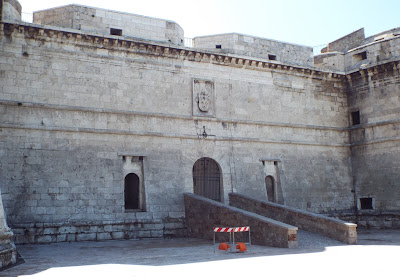Back in March, Sue and I visited Civitavecchia in Italy. It is the main harbour that serves Rome, and the entrance to the harbour is dominated by Fort Michelangelo.
The fort was originally commissioned by Pope Julius II to defend the port of Rome, and its designer was Donato Bramante. The constrcution of the fortress was completed in 1535 by his students, Giuliano Leno and Antonio da Sangallo il Giovane. The upper part of the maschio was designed by Michelangelo, and his name, rather than that of its designer and builders, is generally applied to the fortress.
The plan of Fort Michelangelo is quadrilateral in shape, and it is protected in each corner by a cylindrical tower and has an the octagonal maschio tower in the direction of the port. The four towers are called St. Paul (South-East), St. Peter (South-West), St. Romolus (North-West) and St. Julius (North-East) but are also known respectively as San Colombano, Santa Ferma, San Sebastiano and San Giovanni.
* A maschio tower is a typically Medieval round tower that is taller than the other towers of a fortress.
The fort was originally commissioned by Pope Julius II to defend the port of Rome, and its designer was Donato Bramante. The constrcution of the fortress was completed in 1535 by his students, Giuliano Leno and Antonio da Sangallo il Giovane. The upper part of the maschio was designed by Michelangelo, and his name, rather than that of its designer and builders, is generally applied to the fortress.
The plan of Fort Michelangelo is quadrilateral in shape, and it is protected in each corner by a cylindrical tower and has an the octagonal maschio tower in the direction of the port. The four towers are called St. Paul (South-East), St. Peter (South-West), St. Romolus (North-West) and St. Julius (North-East) but are also known respectively as San Colombano, Santa Ferma, San Sebastiano and San Giovanni.
* A maschio tower is a typically Medieval round tower that is taller than the other towers of a fortress.





























.jpeg)














Bob,
ReplyDeleteThis is a very substantial Fort - remarkable knowing it was completed in 1535...with all our modern technology we'd be battling to build such a structure. Thanks for posting. KEV.
Kev Robertson (Kev),
DeleteIt is even more substantial when seen up close than it appears in the photographs ... and is a true marvel of Renaissance building technique.
All the best,
Bob
I was also impressed by the fortress. Pope Julius was quite a personality for a Pontiff.I wouldnt have liked to cross him.
ReplyDeleteRobbie Rodiss,
DeleteIt is sometimes very easy to forget just how much political and military power the Popes used to have at their disposal, and how much some of them used it.
All the best,
Bob